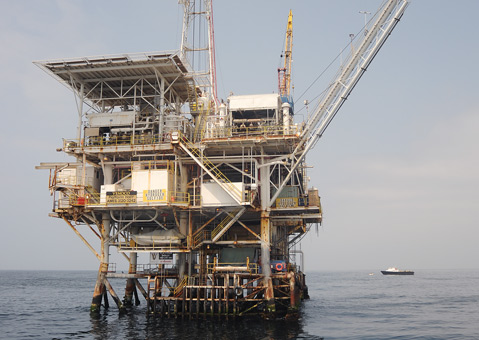Questions Remain Over Offshore Acidizing
Differing Definitions of Technical Terms May Explain Why Platform Holly Dispute Exists

company says no, enviros say yes, and differing definitions may be to blame.
[Editor’s Note: A previous version of this story appears here.]
Last week, one day after a report was released claiming that Venoco Inc. was using a technique known as matrix acidizing to stimulate production from the wells that it accesses from Platform Holly off the Goleta coast, the Carpinteria-based oil company issued a brief statement denying that it was using the process for extraction purposes. “Venoco does not hydraulically fracture or matrix acidize any wells on Platform Holly,” said Venoco spokesperson Lisa Rivas in an email. Instead, she explained that acid is used for cleaning the platform’s well bores, which has been done for several decades. “This is a process that has been used in onshore and offshore oil wells around the world for generations,” Rivas explained.
That’s contrary to the February 11 report published by Santa Barbara’s Environmental Defense Center, whose student intern, Matthew Buggert, researched the state’s public records related to the platform, which is offshore of UCSB’s Coal Oil Point. According to the report and subsequent conversations with EDC attorney Brian Segee, Venoco had, since 2006, applied for and been issued 10 permits whose language suggested that the process was being used to extract more resources rather than just clean wells.
To the EDC and other environmental groups, acidizing, in which hydrochloric and/or hydrofluoric acid is pumped into the ground to free up oil, represents a potentially dangerous situation since the practice has not undergone extra scrutiny, particularly in regard to offshore drilling. To them, it’s just like hydraulic fracturing, a k a fracking, which has caused a loud and constant nationwide uproar. Like fracking, acidizing is currently being analyzed by Senate Bill 4 (SB 4), which will establish a brand-new set of regulations for these well-stimulation techniques by January 2015.
Specifically, Segee said that the records, which were found at the state’s Division of Oil, Gas & Geothermal Resources (DOGGR) in Santa Maria, cited one reference to a “pump acid stimulation job” and further references to “acid job[s]” that used chemicals in the same way. Segee also said that the use of multiple fluids for “preflush,” stimulating, and “overflush” as well as the use of a “diverter” comprising benzoic acid flakes made them more confident of Venoco’s matrix acidizing. (There is also the process of fracture acidizing, which is basically fracking, but with pressurized acid as a base instead of water and chemicals; the EDC report does not suggest Venoco has done this.)
When asked to further clarify that Venoco was denying the allegations raised in the EDC’s report, Rivas explained that the previous statement was all that the company was prepared to say of the matter.
This sort of dispute may be increasingly common, says Briana Mordick, a former oil industry engineer who now works for the Natural Resources Defense Council and has looked at the EDC’s research. As part of the state’s process to develop new regulations over fracking, acidizing, and other well-stimulation techniques via SB 4, Mordick said that DOGGR has created new parameters for what qualifies as stimulation, developing “arbitrary” thresholds related to the concentration of acids and how deep the penetration goes. “This is giving operators the ability to keep doing things without additional oversight,” said Mordick. “There’s not necessarily a technical foundation for that. It’s more of a political move to exempt some of what the industry considers traditional operations.” But many of these practices should be covered by new regulations, believes Mordick, explaining, “When you are injecting these fluids for the purpose of improving the permeability of the formation — regardless of how far it’s penetrating the formation or what concentration of acid you’re using — that’s stimulation by the most fundamental definition.”
Acidizing aside, Venoco’s Rivas assured that the platform is safe and clean. “Platform Holly is a zero-discharge platform — meaning nothing is released to the ocean, not even rain water off the decks of the platform,” said Rivas. “Every drop of fluid is captured and contained. All of Venoco’s offshore and onshore operations are highly regulated, and we pride ourselves on adherence to all state and local regulations. The regulators approve all Venoco’s plans for oil development and receive regular reports on all our operations.”



